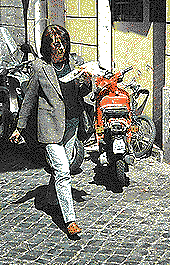|
|
|
|
consuming
passions
The
water
In high summer, Rome is a
hot town. Really hot. But unlike London or Manhattan, cool natural
spring water trickles from drinking fountains on nearly every
Roman street corner.
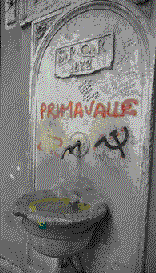
Some of the fountains are
centuries old, and the two thirst-quenchers pictured here, although
not so old, perhaps appear the more venerable underneath their
layers of modern graffiti.
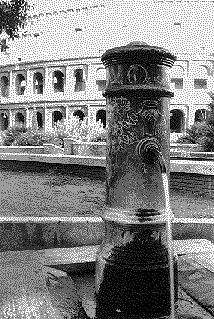
Some are push-button operated, while others flow continuously
into ornate bowls and cisterns carved from stone or marble.
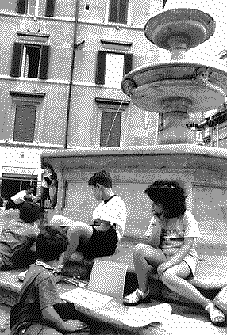
Everybody's on the make - local
children in a quiet piazza off Via Cavour sell their paintings
from the foot of the fountain.
Gypsies and workmen who are
out on the street all day drench their hair under the flow as
a precaution against sunstroke, while more genteel be-suited
businessmen and women discreetly stoop for a quick cool sip as
they pass by.
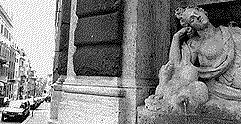
One of the four fountains which
grace each corner at the intersection of Via XX Settembre and
Via Quattro Fontane (Road of the Four Fountains!) This one's
our favourite. We've been criticised for bad composition in this
photograph, but seriously guys, it's intentional - split the
picture right down the middle - On the left is modern Rome...
and on the right is ancient Rome. Put them together again and
you have the true beauty of this crazy city - The new alongside
the old, the hi-tech beside the halcyon, Koyannisquatsi meets
the Mona Lisa.
MORE
REASONS TO LOVE ROME
The
smoking
If you like smoking, Rome’s
the place to do it. Oh, you don't smoke? Too bad dear... You
will certainly be among the minority in Italy. I suppose you
will have to don a gas mask and squirt copious amounts of murine
into your little eyes every time you enter a bar. While there
are many bars and restaurants who operate a smoking ban, this
is largely on account of their proprietors not wishing to lose
the custom of increasing numbers of non-smoking Western tourists.
However, these are the exception rather than the rule, so it’s
possible in most places to enjoy a smoke with your coffee, thus
heightening one’s enjoyment of the perfect Roman moment.
A few years ago it was difficult to find Western brands of cigarettes
in Italy, but this is no longer the case and popular western
brands like Marlboro, Dunhill or Players are freely available
in most ‘Tabachi’ A tabachi as it’s name suggests
is a sort of tobacconist which sells cigarettes (obviously),
other smoking materials (such as nice cigarette cases and lighters
and those rolling machines for fag-papers), sweets, chewing gum,
postage stamps, numerous brands of little mints and breath-fresheners,
small items of stationary like pens and sometimes filofaxes,
plus men’s toiletries and grooming aids. It’s a sort
of newsagents without the newspapers, or a chemist which sells
cigarettes instead of medicine. (as for Newspapers, they’re
mostly sold from news-stands in the street, but you can’t
browse endlessly through the magazines a la WH Smith as most
of the mags are behind the counter. If you want to merge into
the local smoking culture, then smoke the popular Italian brands
such as Diana (mild), or MS (strong).
Respect the smoking conventions though - Even in a bar or restaurant
where smoking is allowed, if it’s lunchtime, or large numbers
of people nearby are eating, keep your distance from them and
the food counter, or wait until your outside again. Be very careful
how you dispose of the cigarette butt - In hot weather these
may start a fire amidst waste litter on the street, or if thrown
from a car, hot, dry grass and shrub foliage can ignite, causing
forest fires. Thus, there are heavy spot fines issued by police
and carabinere for being seen throwing the cigarette butts carelessly.
A delightful feature of Rome’s smoking culture is the inclusion
of ashtrays in the side-panels of almost all rubbish bins in
the city, so there is really no excuse to just toss the butts
away. Finally, though many do, it’s still a bit non-U to
smoke in the street, although this can be excused at stationary
moments during the passeggiata.
MORE
REASONS TO LOVE ROME
the
bars
Bars are a universal
feature of Italian life. Unlike bars in the US or pubs in England,
Italian bars do not merely sell alcoholic drinks, but also a
variety of hot and cold non-alcoholic beverages, the chief being
of course coffee - espresso (caffè) or cappuccino, or
half a dozen other ways of serving it, including chilled (caffè
freddo). Also thé freddo (iced tea, in lemon or peach
flavours) They also sell ice-cream, cakes, and a large selection
of hot and cold snacks, pizza and sandwiches (although the best
pizza can be found in, surprise, surprise, pizzerie, not bars).
Romans eat a lot in
the street - The woman above is a typical sight as she tucks
into her slice of pizza while strolling through the Trastevere
district. Paradoxically though, Romans do never, ever,
ever walk down the street with a can of coke or beer.
It is absolutely not done. If you try it you will be instantly
identified as a tourist. You will also not (as you might think)
save any money buying your drink in a can or cup to take away.
The Romans have hiked the street price of a can of coke up to
about £1.50 Sterling as a subtle penalty to tourists who
refuse to accept the local bars as the customery method of taking
refreshment.
Think of the bar as a café
where you can also get a beer or a cocktail at any hour of the
day (except between around midday and 4pm, when most shops close
for siesta, reopening at around four and staying open till late.
Actually most bars in central Rome are open all day, from about
7.30 am to midnightish, especially in summer when there’s
a lot of thirsty tourists about. But the shops often close at
lunchtime and when they re-open at four, they stay open till
about eight pm.)
The amazing thing is the incredible number and variety of bars.
On any street, there will be a bar every hundred metres or so,
and they range from small standing-room-only affairs comparable
in size to a London taxi-stand greasy-spoon kiosk, up to establishments
which are really small restaurants, or large restaurants with
a small bar attached to their side entrance. The level of service
also varies greatly, but it is rarely ‘bad service’,
for Italians take great pride in the way they serve food and
drink. If the bar is not busy, you may well receive a complimentary
bowl of nuts or crisps with your beer or aperitif, and sometimes
a small chocolate in the saucer of your coffee, and many orders
are presented on smart little trays with paper napkins and metal
spoons. Too long in England have we suffered under the plastic
cup of dishwater called coffee, which we pay a pound for and
then have to always go back to the self-service counter for a
miserable sachet of sugar and a plastic spoon to stir it it with.
Not so in Italy. Even the quickest cheapest coffee is served
with manners and panache. And it is cheap. L.1000 (about 35p
at current Sterling exchange rates) gets you a basic espresso
(called caffè) and a cappuccino goes at around L.1500.
There are some rules of procedure and etiquette in bars which
take some getting used to for the Brit or US tourist though:
The biggest problem for the non Italian-speaking visitor is that
you must pay for your food and drink before you order it. This
can be tricky if you don’t know the Italian name for something.
Neither can you simply point to it and say "one of those
please", as the cash-desk is nearly always at the opposite
end of the room to the food-bar! Even if you sit down at a table
first and order from the waiter, a bar is not a restaurant, and
usually has no portable printed menus, so you need to have a
pretty good working knowledge of Italian vocabulary and cuisine
before you try the 'ordering from the table' trick. Bars usually
(but not always) charge extra for sitting down, sometimes per
table and sometimes per person.
Many bars in the more fashionable areas of central Rome charge
as much as L.1200 or even L.1500 for an espresso, but if you
are in a bar where the price is only eight or nine hundred lire,
it is customary to leave a tip of a one or two hundred lire coin
on the bar-top. Thus, it’s best not to be too tight-fisted
when you go to a bar, expecting price and service conformity
everywhere you go; On the whole you are getting extremely good
value for money in an Italian bar, especially with current sterling
to lire exchange rates. Though Americans may be used to a high
level of service and customer-consideration in bars and restaurants,
British visitors to Rome will certainly be in for a dose of the
finest coffee and snack-bar service you will ever have had in
your life. Pay whatever it costs, relax and enjoy your beautiful
coffee.
|






